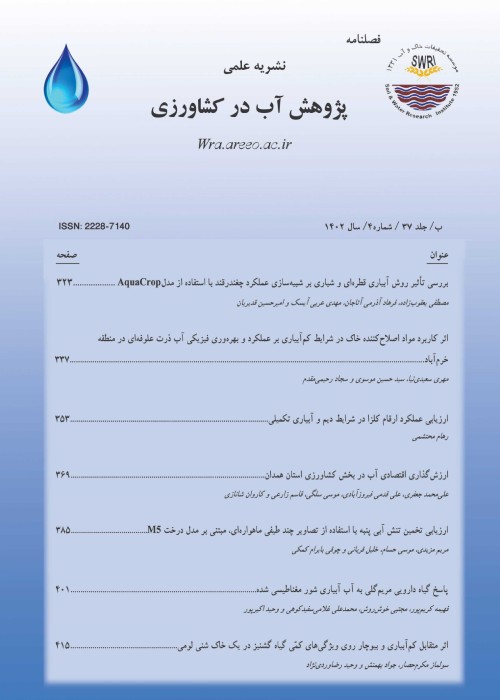Evaluation the Effect of Space and Depth Subsurface Drainage in the Paddy Field in Order to Develop Second Crop in a Sample farm of Guilan
Author(s):
Abstract:
A second crop in paddy fields has economic advantages resulting from the production of crops (canola, beans, garlic, triticale, soybean, etc.), dry rice bed for mechanized harvesting, strengthening the economy of farmers families, increase the incentive for farmers to stay in the village, etc. Due to the inability of the existing surface drainage systems in rapid depletion of water from the root zone, conditions for planting a second crop in paddy fields is not suitable. This can be provided by installing subsurface drainage systems, which, in addition to creating more favorable conditions for planting and harvesting rice, allows cultivation of other crops in the wet season. This research was conducted to determine the appropriate space and depth of subsurface drainage in paddy fields in order to provide favorable conditions for planting a second crop. The experiment was laid out in one and a half hectares of paddy fields at Rice Research Institute of Iran in Guilan province, in 2014. Drainage treatments included: six conventional subsurface drainage systems with rice husk envelope including drainage system with different drain depth and spacing L7.5 D0.8, L10 D0.8, and L15 D0.8, L7.5 D1, L10 D1, and L15 D1, surface drainage, and the control (without drainage). All lines were 40 meters long and made of PVC corrugated pipes with a diameter of 125 mm. Rice husk was used as a covering around the pipe drain. The results showed that subsurface drainage spacing of 15 m had failed to lower the water table depth to an acceptable level and provided the conditions only for the cultivation of shallow-rooted plants such as dill, parsley, and leeks. Also, surface drainage could reduce the excess water in the soil by 22% compared to control. To provide suitable conditions for the cultivation of second crops such as canola and beans, subsurface drainage spacing of 7.5 and 10 m seemed effective. However, to avoid excessive drainages by 7.5 m spacing, subsurface drainage spacing of 10 m was selected as the best space at drainages stage, for a second crop. Furthermore, due to the lack of significant differences in water table depth between treatments L10D1 and L10D0.8,theywere identified as suitable drainage systems at 0.8 m depth.
Keywords:
Language:
Persian
Published:
Journal of Water Research in Agriculture, Volume:30 Issue: 2, 2016
Pages:
159 to 173
magiran.com/p1571385
دانلود و مطالعه متن این مقاله با یکی از روشهای زیر امکان پذیر است:
اشتراک شخصی
با عضویت و پرداخت آنلاین حق اشتراک یکساله به مبلغ 1,390,000ريال میتوانید 70 عنوان مطلب دانلود کنید!
اشتراک سازمانی
به کتابخانه دانشگاه یا محل کار خود پیشنهاد کنید تا اشتراک سازمانی این پایگاه را برای دسترسی نامحدود همه کاربران به متن مطالب تهیه نمایند!
توجه!
- حق عضویت دریافتی صرف حمایت از نشریات عضو و نگهداری، تکمیل و توسعه مگیران میشود.
- پرداخت حق اشتراک و دانلود مقالات اجازه بازنشر آن در سایر رسانههای چاپی و دیجیتال را به کاربر نمیدهد.
In order to view content subscription is required
Personal subscription
Subscribe magiran.com for 70 € euros via PayPal and download 70 articles during a year.
Organization subscription
Please contact us to subscribe your university or library for unlimited access!


